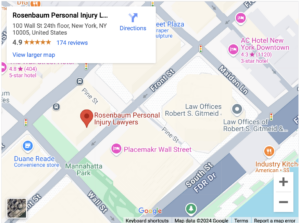Heat safety: 5 tips for New York construction workers
Construction workers and company owners in New York should know how to handle extreme temperatures.
In the thick of summer, the heat in New York is stifling. According to the New York City Department of Health and Mental Hygiene, certain groups of people are more prone to suffering heat illnesses than others. For example, the department notes that of all heat stroke deaths in the city, more than 80 percent were linked to people who were living in conditions without air conditioning.
Construction workers and others who spend long hours outdoors at this time of year are also at an increased risk for experiencing the adverse effects of extreme temperatures. Here are a few tips for staying cool even as the mercury rises:
1. Finding respite
The U.S. Occupational Safety and Health Administration points out that employers must provide a place where workers are free from recognizable hazards. Therefore, there should be a shady place where employees are able to drink water and rest. OSHA also suggests that employers do the following:
- Have a plan in place for a heat-related emergency
- Allow new workers to gradually adjust to working in extreme temperatures
- Ensure workers have access to water
OSHA cites that more than 40 percent of worker fatalities that involve heat occur in the construction industry.
2. Dress appropriately
The construction industry calls for clothing that does not seem conducive to staying cool: hard hats and steel-toed boots, for example. However, there are some measures workers may take to reduce the effects of the heat. For example, using reflective shields on hard hats or other clothing may redirect radiant heat. There are also insulated gloves and suits that are helpful for people who work in extreme temperatures.
3. Plan projects smartly
Experts recommend that companies factor in the temperature when determining schedules and workloads. Whenever possible, jobs that are physically demanding should be reserved for cooler months. Heavier work should be attempted during the cooler parts of the day instead of at midday.
4. Rotate job functions
Another idea is to have workers rotate in and out of positions that involve heat exposure. This minimizes exhaustion and enables employees to get a break from high temperatures.
5. Recognize the signs of illness
Lastly, employers and workers should all be aware of the signs that something is amiss with an employee. Some common signs that the heat is adversely affecting someone include fatigue, dizziness, nausea and a high heart rate. It is possible that the person’s skin will be hot to the touch and dry, as there may be a decrease in sweating. Someone may appear confused or complain of a headache.
As soon as these symptoms appear, it is imperative to seek help immediately. In some cases, victims may be able to file for workers’ compensation to cover the cost of the care needed. Anyone who has questions about this issue should speak with a personal injury attorney in New York.
Contact the New York City Construction Accident Law Firm of Rosenbaum Personal Injury Lawyers for Help Today
If you’ve been injured in an accident in Manhattan, NY, and need legal help, contact our construction accident lawyers at Rosenbaum Personal Injury Lawyers to schedule a free consultation. We also serve in Brooklyn and the Bronx.
Rosenbaum Personal Injury Lawyers – New York City Office
100 Wall St, 24th Floor
New York, NY 10005
(212) 514-5007
Our firm is located near you. We have an office in NYC
Find us with our GeoCoordinates: 40.7051415,-74.0067386
Rosenbaum Personal Injury Lawyers – Bronx Office
1578 Williamsbridge Rd suite 3b
Bronx, NY 10461
(929) 447-2347
Our firm is located near you. We have an office in the Bronx
Find us with our GeoCoordinates: 40.8468944,-73.8483118
Rosenbaum Personal Injury Lawyers – Brooklyn Office
32 Court St #704
Brooklyn, NY 11201
(718) 550-3601
Our firm is located near you. We have an office in Brooklyn
Find us with our GeoCoordinates: 40.692948,-73.991038



